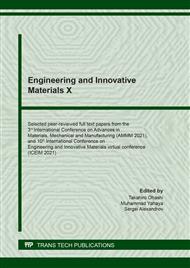[1]
Hamed Aghajani Derazkola, Abdolreza Simchi. A new procedure for the fabrication of dissimilar joints through injection of colloidal nanoparticles during friction stir processing: Proof concept for AA6062/PMMA joints. Journal of Manufacturing Processes. Vol. 49 (2020), pp.335-343.
DOI: 10.1016/j.jmapro.2019.12.008
Google Scholar
[2]
William T. Evans, Chase Cox, Brian T. Gibson, Alvin M. Strauss, George E. Cook. Two-sided friction stir riveting by extrusion: A process for joining dissimilar materials. Journal of Manufacturing Processes. Vol. 23 (2016), pp.115-121.
DOI: 10.1016/j.jmapro.2016.06.001
Google Scholar
[3]
G. Ananda Rao, N. Ramanaiah. Dissimilar metals AISI 304 steel and AA 2219 aluminium alloy joining by friction welding method. Materials Today: Proceedings. Vol. 19 (2) (2019), pp.902-907.
DOI: 10.1016/j.matpr.2019.09.028
Google Scholar
[4]
Onuh Adole, Nilam Barekar, Lorna Anguilano, Timothy Minton, Aleksander Novytskyi, Brian McKay. Fibre/matrix intermetallic phase formation in novel aluminium-basalt composites, Materials Letters. Vol. 239 (2019), pp.128-131.
DOI: 10.1016/j.matlet.2018.12.079
Google Scholar
[5]
H. Nishimura, H. Yamamoto, S. Yamagishi. Fabrication of superplastic Zn-22Al alloy matrix composite. J. Japan Inst. of Light Metals. Vol. 38 (10) (1988), pp.665-671.
DOI: 10.2464/jilm.38.665
Google Scholar
[6]
W.M. Thomas, E.D. Nicholas, J.C. Needham, M.G. Murch, P. Temple-Smith, and C.J. Dawes. Friction Stir Welding. 1991. International Patent Application No. PCT/GB92/02203 and GB Patent Application No. 9125978.8, U.S. Patent No. 5460317.
Google Scholar
[7]
Aadhari, S. and Malkapuram, D. Friction Stir Welding of Aluminum 6082. SAE Technical Paper. 2018. No. 28-0051.
DOI: 10.4271/2018-28-0051
Google Scholar
[8]
Mokadem, Alaa & Elshalakany, Abou. Modeling and Optimization of Friction Stir Welding Parameters for Joining Dissimilar Aluminum Alloys. Advanced Journal of Graduate Research. Vol. 4 (1) (2018), pp.1-14.
DOI: 10.21467/ajgr.4.1.1-14
Google Scholar
[9]
Al-Jarrah, JA, Swalha, S, Mansour, TA. Welding equality and mechanical properties of aluminum alloys joints prepared by friction stir welding. Mater Des. Vol. 56 (2014), pp.929-936.
DOI: 10.1016/j.matdes.2013.12.003
Google Scholar
[10]
Rhodes, CG, Mahoney, MW, Bingel, WH. Effects of friction stir welding on microstructure of 7075 aluminum. Scripta Mater. Vol. 36 (1997), pp.69-75.
DOI: 10.1016/s1359-6462(96)00344-2
Google Scholar
[11]
Mahoney, MW, Rhodes, CG, Flintoff, JG. Properties of friction-stir-welded 7075 T651 aluminum. Metallurg Mater Transact A. Vol 29 (1998), pp.1955-1964.
DOI: 10.1007/s11661-998-0021-5
Google Scholar
[12]
T. Nishihara, Japanese Unexamined Patent Application Publication, No. 2002¬-256453.
Google Scholar
[13]
T. Nishihara, Development of Friction Stir Forming. Mater. Sci. Forum. Vol. 426–432 (2003), pp.2971-2978.
DOI: 10.4028/www.scientific.net/msf.426-432.2971
Google Scholar
[14]
T. Nishihara, A. Ito, Measurement of Die Temperature during Friction Stir Forming. Weld. World, Vol. 49(3/4) (2005), pp.22-26.
DOI: 10.1007/bf03266471
Google Scholar
[15]
K. Yamamura, K. Torikai, and T. Nishihara, Mechanical Interlock of Thin Metallic Wire Using Friction Stir Forming. Friction Stir Welding and Processing VI, ed. by R. Mishra, M. W. Mahoney, Y. Sato, Y. Hovanski, and R. Verma, TMS, Vol. 6 (2011), pp.281-288.
DOI: 10.1002/9781118062302.ch33
Google Scholar
[16]
T. Nishihara and K. Yamamura, Local Manufacture of MMC Using FSW. Mater. Sci. Forum. Vol. 539-543 (2007), pp.3733-3738.
DOI: 10.4028/www.scientific.net/msf.539-543.3733
Google Scholar
[17]
Koshi Yamamura and Tadashi Nishihara, Development of Local Reinforcement and Local Metallic Foam Using FSP. Mater, Sci. Forum. Vol. 638-642 (2010), pp.1267-1272.
DOI: 10.4028/www.scientific.net/msf.638-642.1267
Google Scholar
[18]
Takahiro Ohashi, Hamed Mofidi Tabatabaei, Tadashi Nishihara, Observation of Material Flow in Friction Stir Forming for A5083 Aluminum Alloy Gear-Racks, Material Science Forum. Vol. 889 (2016), pp.113-118.
DOI: 10.4028/www.scientific.net/msf.889.113
Google Scholar
[19]
Mofidi Hamed, Tajima, Tetta and Nishihara Tadashi. Trials of Developing a Magnetic Aluminum Metal Matrix Composite through Friction Stir Spot Forming. Key Engineering Materials. Vol. 777 (2018), pp.17-21.
DOI: 10.4028/www.scientific.net/kem.777.17
Google Scholar
[20]
Mofidi, Hamed & Ishikawa, Ryuji & Nishihara, Tadashi. Mechanical Interlocking of an Aluminum Alloy and SS400 Structural Steel through Friction-Stir Spot Forming (FSSF). Materials Science Forum. Vol. 926 (10) (2018), pp.17-22.
DOI: 10.4028/www.scientific.net/msf.926.17
Google Scholar
[21]
Mofidi, Hamed & Nishihara, Tadashi. Friction stir forming for mechanical interlocking of insulated copper wire and Zn-22Al superplastic alloy. Welding in the World. Vol. 61 (2017), pp.47-55.
DOI: 10.1007/s40194-016-0406-9
Google Scholar
[22]
Mofidi, Hamed & Hara, Takahiro & Nishihara, Tadashi. Production of a Superplastic Vibration-Damping Steel Sheet Composite Using Friction Stir Forming. Materials Science Forum. Vol. 838–839 (2016), pp.574-580.
DOI: 10.4028/www.scientific.net/msf.838-839.574
Google Scholar
[23]
Hamed Mofidi Tabatabaei and Tadashi Nishihara. Friction Stir Forming for Mechanical Interlocking of Ultra-Thin Stainless Steel Strands and Aluminum Alloys. Defect and Diffusion Forum. Vol. 382 (2018), p.114–119.
DOI: 10.4028/www.scientific.net/ddf.382.114
Google Scholar
[24]
Tabatabaei HM, Kobayashi K, Ohashi T, Nishihara T. Effect of Friction Stir Forming Process Parameters on Mechanical Interlock between A5083Alloy and Ultra-Thin Stainless Steel Strands. KEM. Vol. 858 (2020), p.27–32.
DOI: 10.4028/www.scientific.net/kem.858.27
Google Scholar
[25]
Nippon seisen Co.,LTD manufacturer of stainless steel wires. Information on: http://www.n-seisen.co.jp/en/products/naslon.html.
Google Scholar
[26]
K. Yamamura, T. Nishihara: Mater. Sci. Forum, Vol. 638-642 (2010), pp.1267-1272.
Google Scholar
[27]
Mahboubeh Momeni and Michel Guillot, Post-Weld Heat Treatment Effects on Mechanical Properties and Microstructure of AA6061-T6 Butt Joints Made by Friction Stir Welding at Right Angle (RAFSW). J. Manuf. Mater. Process. (2019), 3, 42.
DOI: 10.3390/jmmp3020042
Google Scholar
[28]
Ahmed T, Muhammad W, Mushtaq Z, Bhatty MB, Zaigham H. Mechanical Behavior of Friction Stir Welded AA-6061 Thick Plates in Different Heat Treatment Conditions. KEM. Vol. 875 (2021), pp.203-210.
DOI: 10.4028/www.scientific.net/kem.875.203
Google Scholar
[29]
Japan Aluminum Association website. Information on: https://www.aluminum.or.jp/.
Google Scholar


